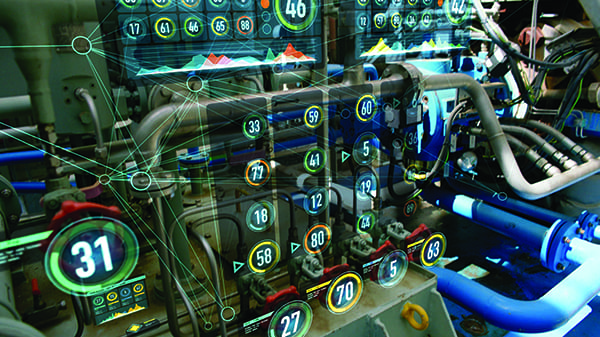A Reimagined Power Future Enabled by Digital Technologies
The power industry is changing and leading companies are turning to digital technologies to revolutionize their operations. Monitoring and diagnostics centers are leveraging vast amounts of data from around the globe and employing machine learning tools to enhance performance and improve asset reliability for customers everywhere.
The world of energy is transforming before us. Take these compelling statistics from the International Energy Agency (IEA): World energy demand is expected to grow 30% through 2040-the equivalent of adding another India and another China to today's existing energy demand. Of this 30% increase, electricity is the rising force among end-users, making up 40% in final consumption to 2040. Electricity use will be driven by the growth of connected devices, more demand for cooling, and the digitalization of modern economies. Furthermore, the IEA expects global electricity generation to grow by 2.3% a year, reaching 30,500 TWh by 2026.
Clearly, to meet this growth, utilities face challenges, such as increasing government policies that vary by region, growing social preferences that lean toward cleaner energy, and emerging technologies that alter the way electricity is generated and consumed. These challenges are shifting the composition of electricity consumers-new customers are emerging with different needs and preferences. Combined, these challenges are causing the world to transition from an electricity system based primarily upon large, centralized generation, and conventional transmission and distribution (T&D) technologies to one that embraces distributed, digitally enhanced, and low-carbon technologies. Traditional and emerging, physical and digital, and large and small are all converging to create a new power network for the future of electricity-a true transformation of today's energy landscape.
Digital Adoption Is Key to InnovationTo compete in this energy landscape of the future, utilities must evolve. They need to rapidly increase their use of digital technologies to improve and innovate traditional energy technologies and fully implement emerging technologies. As digital capabilities grow in use across the industry, they will help power producers innovate. Generators should seek capable partners to shape technologies, transform industrial models, and revolutionize the energy landscape.
Over the next decade, large, centrally located power plants will grow in efficiency and be supplemented by new, often smaller, energy hardware systems that are distributed across the T&D system. This will occur under pressure from government policies that will herd the industry to decarbonize, driving the transition from an electricity system centered upon traditional technologies to one that embraces emerging technologies.
The challenge over the next decade will be cultivating emerging technologies while improving traditional ones so they work together in the 21st-century global power system. As this unfolds, the industry will also experience greater adoption of digital tools that will integrate across existing traditional technologies throughout the electricity ecosystem-in generation plants, within fleet and system-wide control systems, in T&D systems, and even in human resource operations. Utilities will find that emerging technologies such as digital solutions will complement traditional ones-blending them together to create hybridization across technologies, projects, and networks.
Digital optimization, digital power, data security, additive manufacturing, and battery storage will all have a great impact on what the future of electricity looks like.
Digital OptimizationDigital technologies are helping utilities optimize their operations, giving them detailed, actionable insights, and more precise control over their assets. Utilities that use digital optimization will quickly improve power plant efficiency, reduce fuel costs, and increase power capacity, ultimately driving more profitability. They can also extend turndown while maintaining emissions compliance to improve availability, expand fuel flexibility and responsiveness, and decrease start times.
Machine learning-an artificial intelligence (AI) technology that enables systems to learn without being programmed-could play a key role in digital optimization by operating as the "brain" of the power plant. Machine learning is positioned to consume and learn from data at a rate and level of detail impossible for humans to replicate. This could lead to a new level of digital optimization that allows utilities to ramp even faster, taking advantage of the minutest pricing shifts in the market.
Digital PowerThe industry is increasingly employing advanced data analytics to help predict and eliminate unplanned downtime while improving plant reliability and availability. This helps predict potential problems across utility assets, avoid costly unplanned outages, and increase plant flexibility. As data is collected and analyzed (Figure 1), we can expect utilities of the future to become even more predictive and prescriptive by tracking the performance of gas turbines and other assets in real time as the units are producing electricity.
As an example, GE Power operates a global remote monitoring and diagnostic center (Figure 2) where it collects massive volumes of operating data from power generation assets. Each day, more than 50,000 operating hours of data is collected from more than 2,500 globally deployed assets, supplementing a 120-terabyte database and representing more than 200 million fleet operating hours. More than 50 engineers analyze more than 60,000 operational alarms a year, assisting customers in enhancing their asset reliability and performance 24/7/365 and saving them more than $300 million in 2017 alone.
As the industry learns more, we can expect utilities to operate autonomously. AI could write better, more-tailored algorithms that will allow utilities to use a wide assortment of information gathered from asset data pools and devices. Armed with this information, we could see rapid self-analysis and initiation of autonomous corrective actions and circuit configuration changes. Further, voltage and power quality problems, and other physical abnormalities could be quickly discovered and corrected autonomously.
Data SecurityProducing power with digital tools is not without risk. There are increasing challenges to protect systems from advanced cyberattacks and theft of intellectual property. This threat grows as technologies such as remote monitoring and diagnostic applications are added to power systems, multiplying potential attack points.
It's critical to power infrastructures using remote monitoring and diagnostic facilities to provide defenses for digital power production, and GE takes data security very seriously. The company practices a "defense-in-depth" strategy with multiple layers of protection. Specifically, all data from sensors on the machines it monitors comes into a central data collection hub at our customers' sites. Local analytics and data reduction activities run inside the defense perimeter. Then the data passes through cyber protection screens as it leaves the customers' plants. Additional hardware is deployed to ensure that data only flows one direction to the GE data center. Data is encrypted and travels through a secured tunnel on the internet armed with defenses that can signal hacker intrusion, and data arriving at the data center is subjected to additional cybersecurity checkpoints and monitoring.
We can expect to see data security shored up with blockchain technology. Currently, remote access to power infrastructure raises significant concerns because of the potential to hack into systems. Considering authentication and authorization are two fundamental security measures that are in place, blockchain technology could potentially allow transactions to be recorded between two parties in a verifiable and permanent means. It can also be programmed to trigger transactions automatically.
The underlying technology of blockchain allows identification security through public-private encryption with key access. All parties attempting to access power generation infrastructure will be required to verify their identity and authorization for access. Additionally, blockchain technology could eliminate code injection attacks and help provide tamper-proof computer systems that operate critical energy infrastructure-including nuclear power plants and other vital resources.
Additive ManufacturingAdditive manufacturing is an exciting game-changer for many industries, including the energy space, as it disrupts and accelerates the way products are engineered and manufactured. Additive manufacturing will change the energy industry as we know it-shifting workplace and skills requirements, evolving supply chains and business models, speeding up development, and reducing costs.
Advanced manufacturing will be commonplace in the future of electricity with evolutions in rapid prototyping and parts manufacturing for gas and steam turbines or compressors. This will lead to more-rapid development with increased flexibility, improved efficiency, and better materials. 3-D printing will enable advanced technologies with reduced time to market and rapid upgrading of existing assets.
GE recently introduced the new MXL2 with Additive Manufactured Performance-the world's first upgrade solution for GE's GT13E2 gas turbines that uses key components manufactured using additive technology. These components will help the gas turbine run more efficiently and represents a new frontier in turbine engineering and production.
Battery StorageThe future of electricity will encounter a tremendous amount of value with the integration of digital technologies and hybrid power systems tied together through control systems. Hybrid technologies-like batteries and solar photovoltaic systems-will help create power schemes that work together seamlessly to deliver capabilities individual technologies cannot provide.
GE has been a first-mover in battery-integrated generation technologies. Last year, it introduced the world's first hybrid-electric gas turbine to multiple accolades across the industry, and it recently launched the GE Reservoir, a comprehensive energy storage platform that delivers a suite of customized storage solutions in a rapidly transforming power grid.
The FutureIn a recent analysis, GE and Intel found that if just a handful of digital solutions were scaled globally, annual carbon dioxide emissions could be reduced by up to 823 million metric tons, equivalent to roughly 45% of U.S. power emissions in 2015. Digital tools that enable the blending of traditional and emerging technologies will allow the industry to produce electricity faster across a diverse energy mix that includes unconventional oil and gas, renewables-like wind and solar energy-and natural gas.
This can lead to new thinking of how the future of electricity could be-a promising opportunity for the industry and the world. a-
-Scott Strazikis CEO of GE's Power Services business.
The post A Reimagined Power Future Enabled by Digital Technologies appeared first on POWER Magazine.

